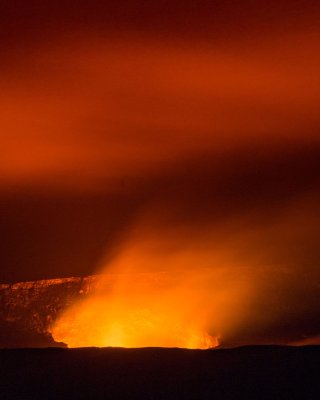11-11-2024
Best Time of Year To Visit Hawaii Volcanoes National Park
This article may contain affiliate links. We earn a small commission at no extra cost to you. Mahalo!
The Big Island has lots to see but none better than Hawaii Volcanoes National Park.
Volcanoes have always drawn a lot of interest. Their sheer majesty coupled with the always-present sense of being surrounded by one of nature’s most unpredictable forces entices us to be a part of them if only experiencing them long past some of their ferocity and only for a short while.
Still today, we all know she will not be tamed. Her presence as the primary owner of the Hawaiian landscape still overwhelms.
This attraction is the creator of memories, but it remains so much more than that. Each visitor will leave with a lot of awe, tinged with more understanding of the importance and significance.
There is no better place to learn and experience more about this force of nature, but when is the best time to go? Let’s discover more about what Hawaii Volcanoes National Park offers and when is the best time to visit.

When Should We Go?
The proximity to the equators allows the warmth many crave during the months of November through March. While many states are begrudgingly moving through the colder weather, visitors to Hawaii Volcanoes National Park will experience the best kind of weather not just for being on vacation, but also to visit the most awe-inspiring attractions.
The Summer months may feel short here, but they are warm and mostly clear. Of course, we are in the midst of tropical paradise here, but that is what makes this island state so perfect.
The most popular months would be from June to September with visitors taking advantage of pre-planned vacation time and school breaks.
In terms of warm to cool, August would rate as the warmest, with February coming in at the coolest, but still favorable.
Clear skies with fluffy clouds will follow you on the best days, and if you do happen to be greeted with a few rain showers, it certainly won’t detract from your experience.

How To Make the Most Out of These Times
Early to Rise
Because this National Park is open 24 hours a day, consider planning to arrive in the early hours of the morning. For those who have experienced this, there is something special about breathing in the morning air, hearing the birds chirping, and watching the sunrise over the beautiful formations.
It is a serenity that many attractions cannot offer.
Sure, everyone likes the economic benefit of tourists to the many areas of the Big Island but one that allows you to experience it outside of normal hours without the hustle and bustle is a true gift.
Be a Night Owl
I direct contract visitors can choose to take on the Hawaii Volcanoes National Park night sky. The starscapes here are vast and will leave you with a real sense of who is really in charge here. It is a humbling experience to watch the night unfold and hear the chatter of wildlife settling in for the night.
For those who walk the trails, some are best for daylight hours but there are walkways and paths you can explore after the sun goes down. Make sure you have a flashlight or headlight with you if you plan to visit at night.
The visitors center and museums close at normal times, but if that doesn’t concern you. Bring something to eat and enjoy the solitude.
Grab Your Free 2025 Guides!
Big Island Intro Visitor Guide
+ Our Summary Guidesheet!
Includes the top must-see & do attractions, best times to visit, a monthly weather & visitor summary, and our tips on how to save when booking your car rental, tours, and activities. Plus, grab our free Big Island Summary Guidesheets. Check out our 2025 Big Island Visitor Guides.

Things To Do During the Best Times of the Year
So, what can you do here?
Hiking is a popular activity no matter what time of the year you choose to visit. The trails are volcanic, and you will find yourself in conversation with others about the history of the park.
Be an explorer. This National Park has over 123,000 acres of wilderness, so for adventurers, there are plenty of places to discover and chances to learn more about the park.
Take a drive. For the self-drivers, some of the roads will lead you to places you never knew existed.
The Crater Rim Drive is stunning, scenic, and leads all who take the journey around the summit of Kīlauea.
The Chain of Craters Road leads down from Kilauea to the ocean. A must-see for those who like to take their time.
Peaceful, green, and inviting, all roads here lead to perfection.

Want To Take a Tour?
If your preference as a visitor is to have a guide with others to meet and talk to about your experiences, taking a pre-planned tour is a great option.
From private to group tours, the guides are experienced, and knowledgeable about the park, and about how to make the most of your day.
Check out the local providers before you go to ensure you make a booking with a provider that gives you all you would want from a trip to this amazing park.

Where is Hawaii Volcanoes National Park?
Located on the Big Island of Hawaii, Hawaii Volcanoes National Park can be found on Highway 11. From Hilo, it’s about 30 miles Southwest.
When’s it Open?
Every day is a volcanoes park day due to this attraction being open 24 hours a day 7 days a week. Perfect for those who don’t have a dedicated itinerary and wish to remain footloose and fancy-free.
What Are We Looking at Here?
The heart of the park is the Kilauea and Mauna Loa active volcanoes. The drive will have you pass steam vents and a museum for education and exhibits on volcanology (yes, it’s a thing). Once you’ve had your fill, move to the viewing area to look at the Halema'uma'u crater.

Tips For an Enjoyable Stay
-
Arrive early if you can. Before 10:00 A.M. or around that time, visitors will find fewer people. The native birds will be in full force for those who wish to see and hear the wildlife without the buzz of chatter.
-
If you happen to see a park ranger, say hello. They have a lot of insight into this area and are full of additional information you may not find elsewhere.
-
If you are driving, planning a bit more time to drive the Chain of Carters Road will pay. Stretching approximately 19 miles, it's an excellent way to take your time and explore the area.
-
Don't forget this park is open 24 hours a day so if you want to avoid the crowds, choose an early or late visit.
-
Although the summer is warm, the area's nature can get relaxed. Bring a light jacket just in case and the appropriate footwear if you are a hiker. You'll do a bit of walking, so leave the high heels behind.
There you have it. A part of Hawaiian history and one that you are unlikely to forget in a hurry. This is the National Park of all National Parks, and beautiful doesn't quite describe it.
Its enormity in historical significance and its continued attraction to visitors from all over the world are only enhanced by the people who love it and take care of it.
Ready to explore the Big Island of Hawaii? So are we. Read more on our site for the best accommodation spots, attractions, and even something out of the ordinary. We'll be right there.
The Big Island of Hawaii welcomes you.
Affiliate Disclosure: We may earn commissions from some travel partners (like Amazon or Expedia) which helps us maintain this site. These links are at no extra cost to you and don't impact our honest & unbiased recommendations. Remove all the ads →




